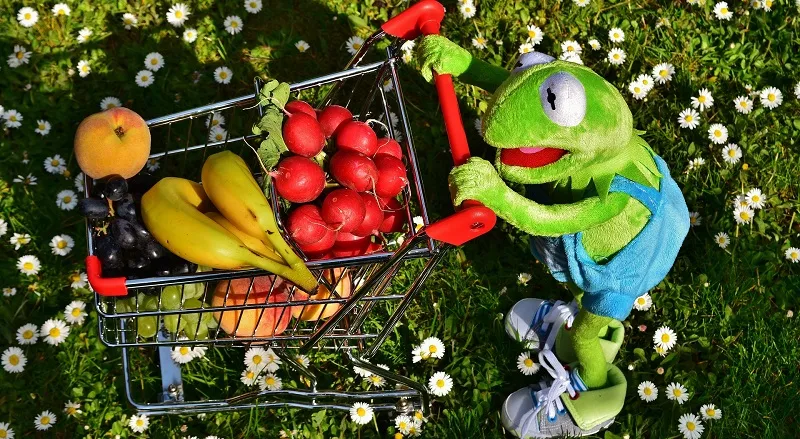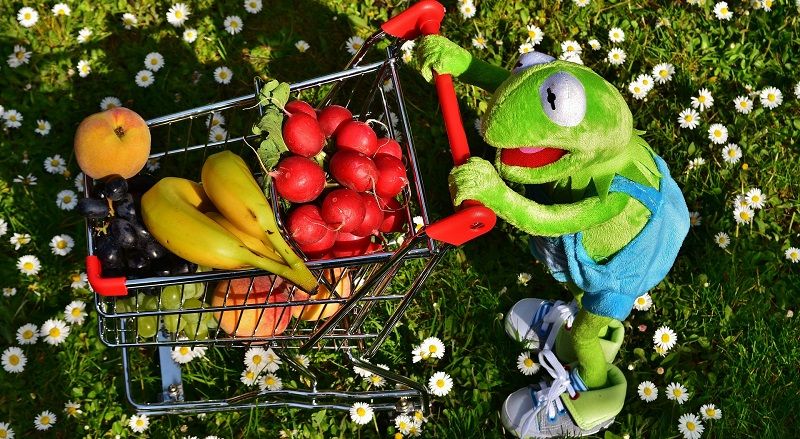As Flipkart and Amazon join the search for the elusive grocery ‘Holy Grail’, lessons from BigBasket and Grofers
Amazon and Flipkart are joining the online grocery quest. We take a closer look at what BigBasket and Grofers, India’s top e-grocers, are doing to understand if these Goliaths can capture a significant chunk of the $566 billion overall grocery market.
Key Takeaways
- Players cannot stick to just branded FMCG, need to offer fresh produce and private labels to get benefit of higher margins
- Supply chain for fresh produce and private label is complex and cannot be set up at scale easily
- Logistics is more complicated and more expensive compared to other e-tail categories
- Category with highest repeat rate; opportunity to build highly loyal customer base
In November, a select set of Flipkart customers in Bengaluru saw the grocery category, Supermart, come alive on their app. A few days later, all Flipkart customers in Bengaluru could buy packaged FMCG on their app.
Cut to many years ago, when Flipkart’s Founder and current Executive Chairman Sachin Bansal had famously said that the company would never sell grocery or automobiles. Yet, here was the company doing just that (it had earlier experimented with a hyperlocal grocery delivery app for a few months).
It was following in Amazon’s footsteps, in a way. Amazon launched the category in 2016, through multiple formats like its hyperlocal Amazon Now to the all-your-groceries-in-a-box Pantry model. But it was only in 2017 that Amazon scaled up its grocery offering.
The why-focus-on-grocery question is an easy one to answer. Grocery makes up for a bulk of the $672 billion retail market. A customer might buy a mobile phone once in a year, but he needs to buy grocery multiple times a month.
BigBasket Co-founder Hari Menon puts it succinctly: “It is the only category that gives repeatability.”
It is also still early days in online grocery, with all firms together selling $1 billion worth of products this year in this category, according to data from advisory firm RedSeer Consulting.
So, there is still a large potential market to capture.
The how-will-they-capture-the-market is the difficult question. Grocery, the world over, is the toughest category to move online. That’s the reason why Amazon in the US and Alibaba in China have only recently started making inroads in this category.
In 2016, online grocery sales in US stood at about $20.5 billion, according to data from Nielsen. Online sales accounts for 3.1 percent of China’s overall grocery market, according to grocery think-tank IGD.

A complex business
To understand what’s so complex about grocery, let’s take a close look at BigBasket’s fresh produce procurement model.
BigBasket has about 300 employees on the fresh produce sourcing side, with 25 collection centres spread across the country. Most of these procure local vegetables and fruits for the 25 tier-I and tier-II cities the company operates in.
Then there are the national sourcing centres, locations where the company sources a product for the entire country. For instance, it sources all its potatoes from Agra, onions from Nashik and oranges from Nagpur.
Each region (like Bengaluru-Mysore) has a buyer, who places his order with the nearest collection centre. Palacode in Krishnagiri caters to both Bengaluru and Chennai regions.
The collection centre fulfils the order and the vegetables and fruits are sent to the regional warehouse for cleaning, processing and packing. The process starts at night and goes on till early morning every single day. This is just for fruits and vegetables.
There is a different process for meat, seafood and private labels, especially in categories like staples and bakery.
BigBasket, which is targeting Rs 2,500 crore GMV in FY 2018 and has a current daily order volume of 50,000, has taken six years to reach this scale and get all these processes in place.
No wonder then that both Amazon and Flipkart are for now focusing on the packaged and branded FMCG segment, which has a far simpler procurement process. A retailer only needs to link up with a few master distributors or brands directly to get the goods to its warehouse.
Amazon Now, the hyperlocal grocery delivery app, has partnered with large-format modern retail stores like Food Bazaar and Hyper City to deliver all grocery items, including fresh produce. But this is available only in four cities—Bengaluru, Delhi-NCR, Mumbai and Hyderabad.
So, isn’t that a good strategy, sticking to branded FMCG goods? The gross margins in this category are lower at around 18 percent and post discounts, which Amazon and Flipkart are offering in abundance, the margins get lower.
Hari says BigBasket gets gross margins of around 24 percent, driven by the mix of fresh produce, private labels and branded goods the company retails.
The other reason Amazon and Flipkart will need to think of offering fresh produce is because of a customer’s typical basket mix in this category.
Customers want to do their monthly or weekly household shopping at one store and the typical basket size is around 25 items. If a customer has to go to another store for groceries and perishables (including say ice creams or curd), he might buy his non-perishables there too.
Both biggies will eventually have to get into these segments. There is already talk of Amazon launching its own private label and fresh produce business, now that it has got government approval to invest $500 million in food retail in India.
The government last year allowed 100 percent FDI in food retail in the country.

What is BigBasket up to?
BigBasket’s inventory-based model was questioned when hyperlocal businesses came up in 2015 and found many backers. But the company did not waver and continued building on its model.
This has worked well for BigBasket, especially now that the hyperlocal model has collapsed - at least in the grocery space - with companies like PepperTap, LocalBanya and GrocShop shutting down.
In the past six years, it has put the infrastructure in place and perfected its business model. Apart from the 25 collection centres, it has 14 warehouses and 55 dark stores through which it does express deliveries.
BigBasket has been focusing on scaling up its fresh produce and private label business for many months now. The entire sourcing process mentioned earlier is the strong defensible moat that BigBasket has built, Hari says.
Your quality perception is not driven by you stocking Surf Excel. The perception that BigBasket is good on quality – that’s driven by fresh produce and staples like rice, meat, diary (milk and ice cream may be branded but last-mile cold chain adds to complexity). This segment is the most complex and that is our biggest differentiator,” says Hari, who claims Bengaluru and Hyderabad are now operationally profitable for BigBasket.
Since BigBasket brands its fresh produce, this falls under its private label segment. For its non-fresh produce private labels, the Bengaluru-based company has different processes for different categories.
In bakery, for instance, it has outsourced the baking though the service provider follows BigBasket’s recipes. In case of staples like rice, BigBasket procures products in bulk from mills and a service provider fumigates, cleans and breaks the bulk into smaller packs for the company.
Private label overall accounts for 35 percent of the company’s GMV. Of this, fruits and vegetables account for 18 percent.
BigBasket also distributes its private label through around 2,000 kirana stores.
Another important piece is organic. Seven of the 25 collection centres are purely for organic produce and 60 percent of the staples are organic. The company is now expanding its private label into non-food segments like wipes and tissue paper.
“For us to get into private label, it must be a significant part of a consumer’s basket and we should be able to bring in differentiation,” says Hari, who is all set to launch a membership programme later this month.
What’s Grofers up to?

The Grofers journey has more insights for new entrants as the Gurugram-based company has completely changed its business model.
Grofers started out as a hyperlocal delivery business, but went through a painful transformation to become an inventory-holding grocery business last year onwards.
Albinder Dhindsa, Co-founder of Grofers, says it took them time to realise that a customer expected to get all items in his order list from one source when ordering online and would not be very forgiving of availability issues.
The team at Grofers recognised they would need control of the entire supply chain to offer that reliability.
“We realised we couldn’t scale without changing our strategy. Most of 2016 we tried figuring out how to work with inventory. But we were still not clear about the value proposition we were offering,” Albinder says.
They zeroed in on the value/budget segment as they were building up their inventory backend.
By February this year, we decided to target the customer who is price-sensitive, the price-conscious middle class. They will wait a day to get a product as long as the price is right,” he says
This segmentation, which ensures it is not in direct competition with BigBasket, has worked well for Grofers with sales tripling between February and now. Average daily order volumes are now at 25,000.
Grofers has four collection centres in Delhi, Mumbai and Bengaluru for fresh produce. Here, it has opted for a smaller number of SKUs as it focuses on the most regularly bought products in line with its value segmentation.
In packaged goods category, Grofers has partnered with lesser-known value brands in each region.
For instance, they have brought Rishta wheat flour online. This brand was found only in the wholesale market and had no distribution chain of its own. A 10kg pack of Rishta flour is cheaper than big brand competitors by about Rs 50, a big difference for a value-conscious customer.
The company has also used technology to keep costs low.
“Everything is done through the mobile phone, even billing. So product movement reduces a lot and this improves efficiency,” says Albinder, who claims to have hit a revenue run rate of $100 million.
The company now operates in 25 cities and Albinder says the focus is on improving efficiency while not compromising on scale.
Grofers is growing at 15 percent month-on-month.
One of the next steps for the company is to build larger warehouses. In Gurugram, the company was operating out of a 25,000 sq ft warehouse; it is now opening a 1 lakh sq ft facility.
“Building for scale will be our theme for 2018,” Albinder says.
Do Amazon and Flipkart have a chance?
Amazon has done well in the packaged FMCG category. Manish Saigal, Managing Director at advisory firm Alvarez & Marsal, says:
Online grocery was at around $600 million last year and is at about $1 billion this year. A lot of the growth is due to Amazon. Last year Amazon didn’t have any real presence in this category and now it is neck and neck with BigBasket and Grofers.”
But he feels the biggest challenge in this category is “margins”. “Brick and mortar too struggled with this,” he adds.
Manish, an expert in logistics, says cost of fulfilment is still quite high in this category at about Rs 120 per delivery. This needs to come down to the Rs 70 to Rs 80 range, like the rest of e-tail, for grocery to become viable.
This is where private labels and fresh produce can help shore up margins. However, those segments add to complexity as mentioned earlier.
How well Amazon and Flipkart manage this complexity at scale will impact their performance.
Others will struggle with their playbook. They have multiple categories which are priority. Between launching a new phone or a grocery product, Flipkart will choose the phone. BigBasket we take seriously, but our paths have diverged significantly and we go after different customer segments,” Albinder says.
He says it took them time to understand that they cannot go after different tiers of the grocery customer with one product.
“We had to make peace with not going after the express customer and the premium customer,” he says.
Similarly, Amazon and Flipkart too will have to choose.
“Also, each order we ship has an average of 16 items. That is very different from shipping a mobile phone or a fashion item. You can’t apply the same logic or tech. This has not been solved globally and so there is no playbook to replicate,” Albinder adds.
But he says if online players are able to replicate the different tiers like the offline world then they can get more consumers to shop for grocery online.
In physical retail, mom-and-pop stores, large modern trade chains and specialised gourmet outlets cater to different segments. The opportunity is there for Flipkart, Amazon and, of course, Grofers and BigBasket to carve their own niches in this category.
As Hari of BigBasket says:
More players need to enter to grow this category. It sounds counterintuitive. But this is the most difficult category for customers to shift online. There is huge inertia to make that shift. So a lot of noise is needed and for that we need more players.”
(With inputs from Athira A Nair)











![[Funding alert] Electric vehicle startup Simple Energy in talks to raise $1M](https://images.yourstory.com/cs/2/11718bd02d6d11e9aa979329348d4c3e/Imagehrn6-1595836341886.jpg)